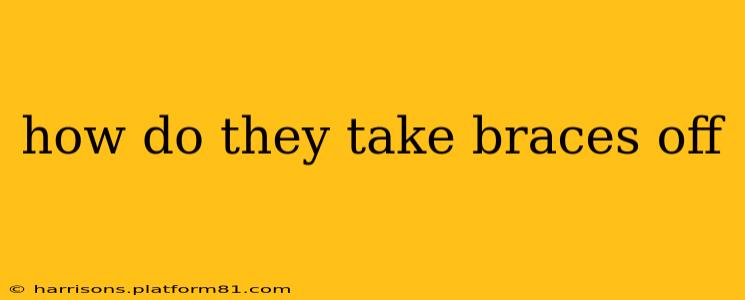How Do They Take Braces Off? A Comprehensive Guide
Getting your braces removed is a momentous occasion, marking the end of a journey towards a straighter, healthier smile. But how exactly does the process work? It's more involved than you might think! This guide will detail the procedure, answer common questions, and address any concerns you might have.
What Tools Do Orthodontists Use to Remove Braces?
The removal process itself is relatively quick and painless. Your orthodontist will use a specialized tool called brace removal pliers. These pliers are designed to carefully detach the brackets from your teeth without causing damage to the enamel. They gently apply pressure to the tiny metal attachments, releasing them from the bonding agent that holds them in place. Think of it like carefully peeling a sticker off a surface—precision is key!
The Step-by-Step Brace Removal Process
-
Bracket Removal: The orthodontist begins by using the pliers to systematically remove each bracket from your teeth. This is done one by one, working their way around your mouth. This part takes the longest, but each bracket comes off quickly.
-
Debonding: Once the brackets are off, the orthodontist uses a small instrument to remove any remaining adhesive from your teeth. This adhesive is a special dental cement designed to hold the brackets securely in place. The residual cement is carefully scraped away to leave the teeth clean and smooth.
-
Wire Removal: After the brackets are removed, the archwire that connected them is easily taken out.
-
Polishing: Finally, your teeth are polished to ensure a smooth, comfortable surface. Your orthodontist may use a rubber cup and polishing paste to remove any remaining cement or rough spots. This step leaves your teeth feeling clean and smooth.
What Happens After Brace Removal?
Following the removal of your braces, you'll likely have a retainer fitted. Retainers are essential to prevent your teeth from shifting back into their original positions. There are several types of retainers, including clear plastic aligners, removable wire retainers, and bonded retainers (which are cemented to the back of your teeth). Your orthodontist will recommend the best option for your specific case. Regular check-ups are vital during the retention phase to monitor your teeth and ensure they remain stable.
Does Removing Braces Hurt?
The actual removal of braces is generally painless. While you might feel a little pressure as the brackets are detached, it shouldn't be painful. However, you might experience some minor sensitivity in your teeth in the days following removal due to the removal of the cement. This sensitivity is usually short-lived and can be managed with over-the-counter pain relievers.
How Long Does It Take to Remove Braces?
The whole process, from start to finish, typically takes between 30 to 60 minutes. The exact time depends on the number of brackets and the complexity of the case.
What Should I Expect After My Braces Are Removed?
- Slight Sensitivity: Expect some mild tooth sensitivity for a few days after the removal.
- Retainer Use: You will need to wear a retainer as directed by your orthodontist to maintain the results of your treatment.
- Follow-up Appointments: You’ll have follow-up appointments to monitor your progress and adjust your retainer if necessary.
Remember, this information is for general knowledge and shouldn't replace professional advice. Always consult your orthodontist for personalized guidance and care. They can answer all your specific questions and ensure you have a comfortable and successful experience throughout the brace removal and retainer phases.
